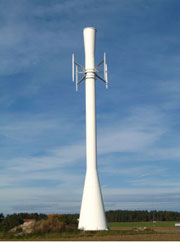 Telecommunications provider Ericsson (ERIC) unveiled Thursday its latest energy-optimized radio base station site concept, a research project for a wind-powered Tower Tube. The wind-powered Tower Tube, designed by the Scandinavian architect Thomas Sandell, is a construction that houses base stations and antennas, fully encapsulating them in an aesthetic, energy-efficient and low environmental impact tower.
Telecommunications provider Ericsson (ERIC) unveiled Thursday its latest energy-optimized radio base station site concept, a research project for a wind-powered Tower Tube. The wind-powered Tower Tube, designed by the Scandinavian architect Thomas Sandell, is a construction that houses base stations and antennas, fully encapsulating them in an aesthetic, energy-efficient and low environmental impact tower.
The idea is based on the concept of radio base stations [RBS] being enclosed within the tower. They are initially installed at the bottom of the tower and then raised to the top by an elevator. By positioning a RBS at height, there is very low feeder loss, which allows improved network coverage and capacity.
The wind-powered Tower Tube takes the energy-lean design of Ericsson’s Tower Tube one step further by employing renewable energy. It harnesses wind power via a four-blade turbine with five-meter blades vertically attached to the tower. The vertical rotor blades work silently and minimize the load on the tower during operation. Vertical wind turbines can have some noise-cutting, cost-cutting and reliability advantages over traditional spinning windmills and may be perfect for in-city wind electricity generation.
Furthermore, the Ericsson Tower Tube has no need for feeders and cooling systems. With up to 40% lower power consumption than traditional base station sites, it helps operators reduce their operating costs significantly.
The Swedish telecom co. partnered for the project with turbine maker Vertical Wind AB, a company which develops and manufactures the wind power technology based on a vertical wind turbine connected to a permanent magnetised direct driven generator, and Uppsala University in Sweden, the oldest university in the Nordic countries, to incorporate a vertical-axis wind turbine into the tower.
The partnership follows a series of initiatives from Ericsson to improve energy efficiency, reduce environmental impacts and lower the costs of mobile networks for operators.
Ulf Ewaldsson, Vice President and Head of Product Area Radio at Ericsson, said:
Combining wind power with Ericsson’s Tower Tube brings further opportunities to support mobile communication in both urban and remote areas with no or limited access to the electricity grid.
This project is part of Ericsson’s ongoing Communications Expander campaign, under which the company uses solar and wind energy when possible to power its network.
Disclaimer: This page contains affiliate links. If you choose to make a purchase after clicking a link, we may receive a commission at no additional cost to you. Thank you for your support!


Leave a Reply